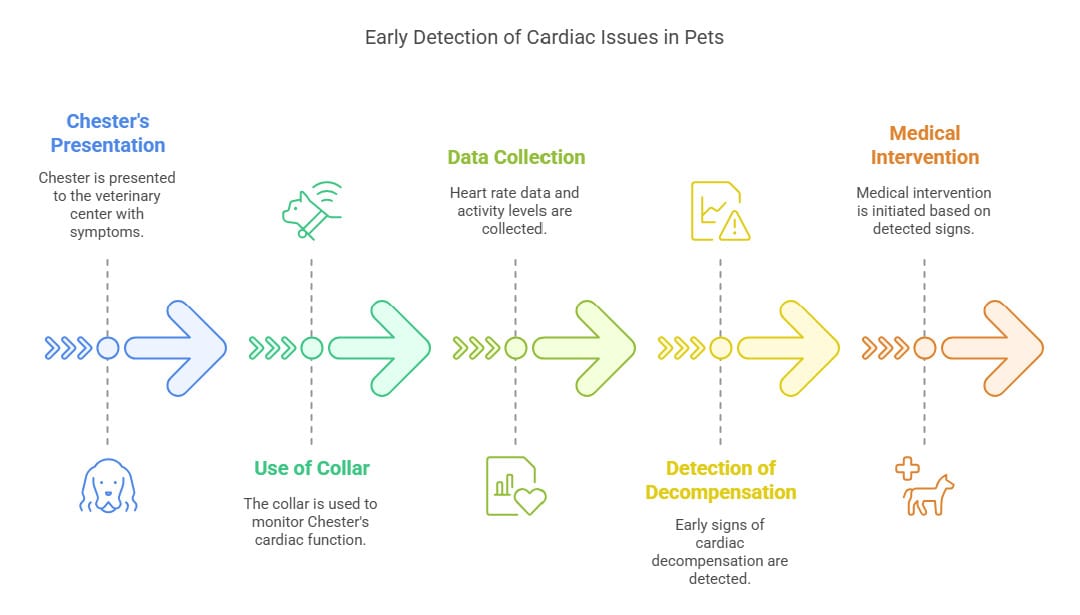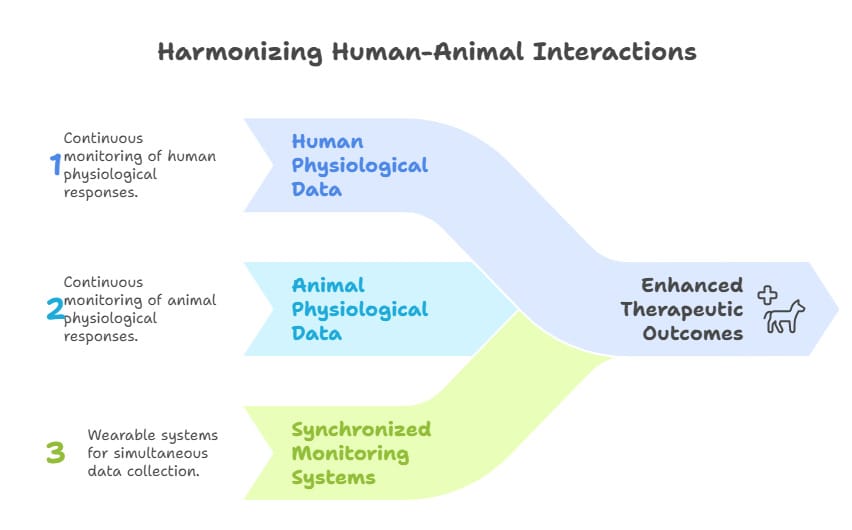The previous article in our series explored how wearable technology has evolved from human healthcare applications to veterinary medicine, detailing the scientific principles behind these innovations. Moving from theory to practice, this second installment examines documented case studies where pet wearables have directly contributed to improved health outcomes through early detection and intervention. These real-world examples provide compelling evidence of how digital monitoring technologies are transforming veterinary care in clinically significant ways.
Post-Surgical Monitoring: Detecting Pain Before It Escalates
Effective pain management following surgery remains one of the most challenging aspects of veterinary care. Unlike human patients who can verbally communicate their discomfort, veterinarians must rely on behavioral cues and physiological parameters to assess animal pain levels. Wearable technology is providing an objective window into post-operative recovery.
Case Study: Real-Time Pain Detection Following Orthopedic Surgery
At TotalBond Veterinary Hospital in Gastonia, North Carolina, veterinarians utilized a smart collar ( PetPace ) to monitor a 4-year-old spayed female pit bull mix named Nix following tibial-plateau-leveling osteotomy (TPLO) surgery for a torn ligament in her right knee. The wearable technology continuously tracked Nix's vital signs during recovery, providing the clinical team with real-time data (ref)
The smart collar registered that Nix rested comfortably for nearly three hours post-surgery. However, the device then detected a significant rise in her pulse rate that coincided with behavioral signs of pain, including restlessness and vocalization. This objective physiological data prompted the veterinarian to administer morphine, which subsequently helped the patient relax and continue healing (ref).
"Continuous monitoring through wearable technology can detect subtle physiological changes that might otherwise go unnoticed until pain becomes more severe," notes Teresa Lightfoot, Director of Medical Services at TotalBond Veterinary Hospital. "In post-surgical cases like Nix's, catching pain early allows for more timely intervention and potentially improves recovery outcomes."
Trauma Recovery: Monitoring Healing After Injury
Traumatic injuries require intensive monitoring during recovery to ensure appropriate pain management and detect potential complications. Wearable technology can provide continuous data streams that complement periodic clinical examinations.
Case Study: Documenting Recovery After Vehicular Trauma
Moli, a 4-year-old spayed female Siberian Husky cross, suffered injuries after being hit by a car. Her recovery was monitored using a #PetPace Health 2.0 smart collar, which documented pain and discomfort levels following the traumatic event (ref).
The wearable device tracked changes in multiple physiological parameters throughout Moli's recovery process, providing veterinarians with objective data about her pain levels and healing progression. This continuous monitoring allowed for adjustments to pain management protocols based on physiological indicators rather than relying solely on periodic clinical assessments5.
"With trauma cases, the ability to continuously track vital signs and activity levels gives us insight into both pain management effectiveness and subtle indicators of healing," explains Dr. Asaf Dagan, Chief Veterinary Scientist at PetPace. "The technology essentially provides thousands of data points between clinical examinations."
Cardiac Condition Management: Early Warning Systems for Heart Disease
Cardiovascular conditions in pets can progress rapidly, with subtle changes preceding acute decompensation. Continuous monitoring outside the clinic environment can detect these early warning signs.
Case Study: Heart Disease Detection in a Cocker Spaniel
Chester, a 10-year-old male American Cocker Spaniel weighing 43 pounds, was presented to MediVet Warbreck House Veterinary Centre in Liverpool, UK, with weakness, lethargy, and labored breathing. Chester had a complex medical history including chronic kidney disease, hypothyroidism, hypertension, and orthopedic issues (ref).
A PetPace collar was utilized to monitor Chester's cardiac function continuously. The wearable technology provided the veterinary team with heart rate data, heart rate variability, and activity levels, which helped detect early signs of cardiac decompensation that warranted medical intervention5.
"Wearable monitors offer a significant advantage in cardiac patients," notes Dr. Mark Epstein, a veterinary pain specialist and past president of the INTERNATIONAL VETERINARY ACADEMY OF PAIN MANAGEMENT . "The technology can detect subtle changes in heart rate and heart rate variability that may indicate worsening cardiac function days before an owner might notice clinical signs."

Rare Condition Management: Monitoring Congenital Vascular Anomalies
For patients with rare conditions, continuous monitoring can be particularly valuable in understanding disease progression and treatment response, especially when limited clinical experience exists with the condition.
Case Study: Monitoring a Husky Puppy with PRAA
Kira, a five-month-old female Husky puppy weighing 10 pounds, was presented to Herzliya Veterinary Hospital in Israel due to repeated regurgitations and weight loss. Following extensive diagnostic workup, Kira was diagnosed with a rare congenital vascular anomaly called Persistent Right Aortic Arch (PRAA) (ref).
A smart collar was employed to track Kira's vital signs, activity levels, and posture changes to monitor her response to treatment. The continuous data collection helped veterinarians assess the effectiveness of interventions and make appropriate adjustments to her management plan based on objective physiological parameters (ref).
Chronic Pain Assessment: Objective Monitoring for Osteoarthritis
Chronic pain conditions like osteoarthritis present unique monitoring challenges, as changes occur gradually and can be difficult to assess objectively during periodic veterinary visits.
Case Study: Detecting Pain Signals in Canine Hip Dysplasia
Pippa, a nine-year-old spayed female Labrador Retriever weighing 61 pounds, had suffered from hip dysplasia since a young age. Her condition was monitored using a PetPace collar to track physiological parameters and activity patterns (ref).
The wearable device provided data on Pippa's movement patterns, rest periods, and physiological indicators of pain, allowing for more objective assessment of her chronic condition. This continuous monitoring helped veterinarians evaluate the effectiveness of pain management strategies and make data-driven adjustments to her treatment plan5.
"For chronic conditions like osteoarthritis, wearable technology provides something we've never had before—objective, longitudinal data on how the patient is doing in their home environment," explains Dr. B Duncan X Lascelles, Professor of Translational Pain Research at NC State College of Veterinary Medicine. "This gives us insight into the progression of disease and response to treatment that simply isn't possible with periodic examinations alone."
Behavioral Health Monitoring: Technology for Shelter Adoption Success
Beyond physical health, wearable technology has shown promise in monitoring and improving behavioral health outcomes, particularly in shelter medicine.
Case Study: Reducing Return Rates Through Activity Monitoring
Researchers examined whether using dog activity monitors could reduce the return rate of newly adopted dogs from shelters. Twelve participants were provided with information about their newly adopted dogs' daily activity and rest levels via commercially available dog activity trackers attached to the dogs' collars and synchronized with a mobile application for eight weeks (ref).
The study showed that providing health and activity-related data to adopters through the mobile application resulted in a decrease in dog re-relinquishment rates. The findings also demonstrated reported changes in both dogs' and adopters' habits, including increased activity levels and time spent together based on the information provided via the trackers (ref).
Dr. Judi Stella, animal welfare scientist at Purdue University College of Veterinary Medicine & Veterinary Hospital, notes: "The ability to objectively track a new pet's activity and rest patterns gives adopters insight into normal behavior for that individual animal. This technology helps bridge the communication gap between animal and human during the critical adjustment period after adoption."
Integrated Human-Animal Monitoring: Dual Benefits in Therapeutic Settings
In therapeutic settings where animals and humans interact closely, simultaneous monitoring can provide valuable insights into the physiological effects of these interactions on both species.
Case Study: Synchronized Monitoring in Canine Assisted Therapy
Researchers developed a system to collect simultaneous and continuous physiological data from both human participants and therapy dogs during Canine Assisted Interactions (CAI). The wearable system incorporated custom-designed and commercially available sensor devices to monitor parameters including heart rate, movement patterns, and stress indicators in both the human and canine participants (ref).
This synchronized monitoring approach provided objective data on the real-time dynamics of therapeutic interactions, moving beyond traditional survey-based pre- and post-session evaluations. The study represented the first attempt to deploy synchronized wearable systems on both humans and dogs during therapeutic interactions (ref).
"By monitoring both the human and animal simultaneously during therapeutic interactions, we gain unprecedented insight into the physiological synchrony that occurs," explains Dr. Aaron Massecar, Executive Director of the Veterinary Innovation Council. "This data helps us understand not only the benefits for human participants but also ensures the wellbeing of the therapy animals involved."

Supporting Walking Therapy: Objective Movement Assessment
For both humans and animals participating in walking therapy, wearable technology can provide objective assessment of movement parameters and physiological responses.
Case Study: Dual Monitoring During Human-Dog Walking
Researchers designed and validated a wearable system for assessment of physiological parameters during walking sessions involving both humans and dogs. The study involved a human (age 40, height 1.80 m, weight 80 kg) walking with dogs of three different sizes, conducted on a rectilinear walkway with multiple repetitions (ref).
The dual monitoring system showed a mean error of ≤0.6% in step counting and demonstrated the feasibility of using parameters that correlate human and dog motion activity. The study highlighted the potential for wearable technology to generate medical knowledge around Canine Assisted Therapy during walking activities and investigate the scientific relevance of these therapeutic interventions (ref).
The Clinical Impact of Continuous Monitoring
These case studies illustrate the transformative potential of wearable technology in veterinary medicine across diverse clinical scenarios. From post-surgical recovery to chronic disease management, objective data collection enables earlier intervention, more precise treatment adjustments, and improved patient outcomes.
Dr. Christopher Pachel DVM, DACVB, CABC, a board-certified veterinary behaviorist at Animal Behavior Clinic in Portland, Oregon, summarizes: "What makes wearable technology so valuable is that it allows us to see what's happening with patients during the 99.9% of time when they're not in our clinic. This continuous data stream, particularly when integrated with artificial intelligence for pattern recognition, has the potential to revolutionize how we detect, diagnose, and treat veterinary patients."
As these technologies continue to evolve and accumulate validation data, they are increasingly becoming standard tools in the veterinary toolkit, offering new insights into animal health and well-being that were previously inaccessible.
In our next blog, we'll delve deeper into "Movement Matters: How Activity Sensors Track Your Pet's Health," exploring the specific sensor technologies that enable activity monitoring in pets and how accelerometers and gyroscopes translate physical movement into meaningful health insights.

